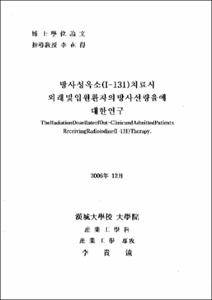방사성옥소(I-131)치료시 외래 및 입원환자의 방사선량율에 대한 연구
- Files in This Item:
-
-
Download
 000000557040.pdf
기타 데이터 / 2.33 MB / Adobe PDF
000000557040.pdf
기타 데이터 / 2.33 MB / Adobe PDF
-
Items in Repository are protected by copyright, with all rights reserved, unless otherwise indicated.
 000000557040.pdf
기타 데이터 / 2.33 MB / Adobe PDF
000000557040.pdf
기타 데이터 / 2.33 MB / Adobe PDFItems in Repository are protected by copyright, with all rights reserved, unless otherwise indicated.